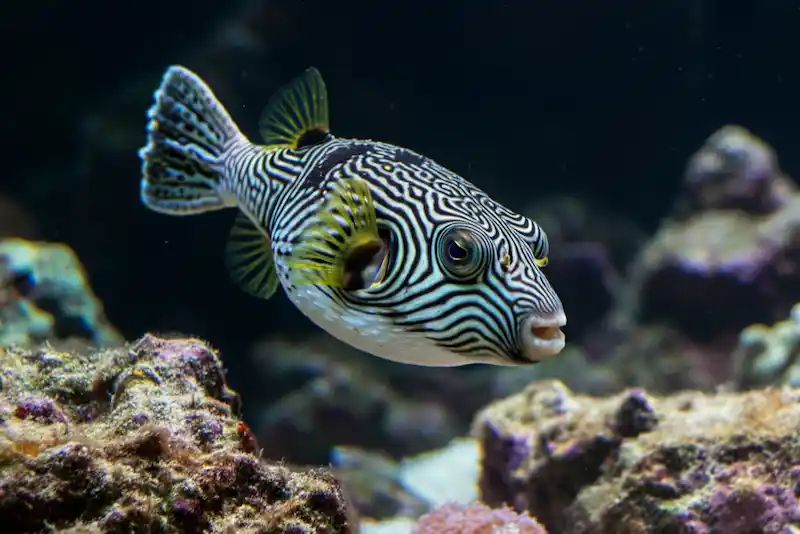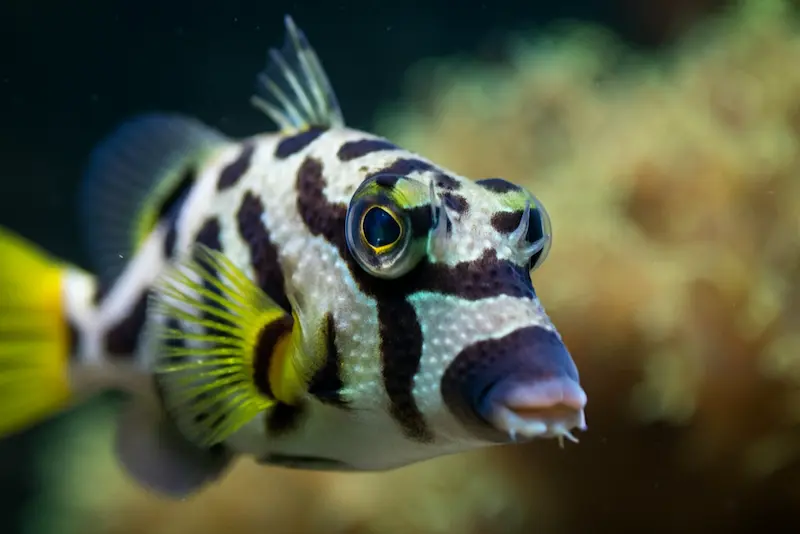Valentini Puffer: The Ultimate Tips for Happy and Healthy Fish
Updated: 10 Dec 2024
32
Have you ever wondered what makes the Valentini Puffer a stunning and unique addition to any marine aquarium? These cute, colorful fish are visually appealing and have unique personalities that attract attention. Their inflatable body and itchy teeth can be a delight to observe, but they also have specific needs to thrive in your tank.
In this article, you will learn everything about the Valentini Puffer, from its diet preferences to its compatibility with tankmates and inverts. Whether an experienced fish keeper or a newbie, you’ll find valuable insights on maintaining a healthy, happy pufferfish.
Keep reading to uncover all the essential tips and tricks for caring for this hard-to-find yet incredibly rewarding aquatic pet.
Specie Overview
The Valentini Puffer Fish, scientifically known as Canthigaster valentini, belongs to the Canthigaster genus and the Tetraodontidae family. These fish are well-known for their capability to inflate their bodies as a defense mechanism, which makes them quite fascinating. They are commonly referred to as the Saddle Puffer or Black Saddled Toby due to the distinctive black markings forming saddle-like shapes on their white bodies. This unique feature gives them their striking appearance, and it’s one of the reasons they are so popular among fish keepers.

Natural Habitat
The Valentini Puffer Fish thrives in the warm waters of the Indo-Pacific region. You can often find it in shallow coral reefs, lagoons, and coastal areas full of marine life. These habitats provide a perfect mix of shelter and food sources, such as mollusks and crustaceans, essential for the fish’s diet.
The Valentini Puffer prefers water temperatures between 75°F and 82°F. It typically resides at depths ranging from 3 to 50 feet. The complex structures of coral reefs offer hiding spots that allow the Valentini Puffer to evade predators. These spaces also give the fish room to explore, catering to its curious and active nature. The ecosystems of these reefs play a crucial role in supporting the Valentini Puffer’s survival. They provide the right conditions for this fish to thrive in the wild and a carefully maintained aquarium environment.
Physical Appearance
The Valentini Puffer Fish is a small, unique species that grows up to around 4 inches long. Its body is oval-shaped and slightly elongated, giving it a compact and dynamic appearance that perfectly matches its lively personality. The fish’s coloration is primarily white, with bold saddle-like black markings running across its back, earning it the nickname Saddle Puffer. Adding to its charm, it has brown stripes along its dorsal area, while vivid blue and yellow accents near its eyes and tail give it vibrancy. Its protruding eyes, which can move independently, give it a playful and watchful demeanor, making it a delight for observers.
One of its most distinctive features is its scaleless, tough skin, which offers extra protection from predators in its coral reef habitat. The Valentini Puffer also has sharp, beak-like teeth that are perfect for crushing the hard shells of mollusks and crustaceans, which form a significant part of its diet. When threatened, it can inflate its body by swallowing water, making itself appear more significant and less appealing to predators. These amazing physical adaptations safeguard the fish and allow it to stay curious, active, and confidently engage with its complex environment.

Behavior and Temperament
The Valentini Puffer Fish is a fascinating creature known for its playful and curious personality. This bold little fish brings excitement to any aquarium or marine ecosystem. It loves exploring its surroundings, getting into every nook and cranny. The Valentini Puffer enjoys interaction with its tank mates and often investigates decorations and potential food sources. While its spirited temperament is charming, its curiosity can lead to occasional nipping at fins or smaller creatures. This behavior isn’t out of aggression; it’s simply a part of its inquisitive nature. Fish enthusiasts find this mix of endearing and challenging traits part of what makes the Valentini Puffer unique.
Regarding defense, the Valentini Puffer has a remarkable survival tactic. If it feels threatened, it can inflate dramatically by gulping water or air, making it appear larger and helping to scare away potential predators. This unique ability emphasizes its boldness despite its small size. However, keeping this species in captivity comes with special considerations. It thrives best in an aquarium with plenty of hiding spaces, crevices, and varied structures, which help mimic its natural habitat. Choosing tank mates is crucial to avoid conflicts, as timid or slow-moving fish may not be compatible with the Valentini Puffer’s lively demeanor. Providing environmental enrichment, like toys or live rocks, keeps the active mind engaged and happy. With its captivating personality and unique needs, this fish can be rewarding and demanding for dedicated marine enthusiasts.
Tank Requirements
Creating the proper tank requirements for the Valentini Puffer Fish is crucial for its health and well-being.
Water Quality
One of the most critical factors is water quality. This species is sensitive to changes in water conditions, so regular monitoring and maintenance are essential. It thrives in well-filtered water with minimal levels of nitrates and ammonia. These substances can quickly become toxic. Frequent water changes of about 10-15% weekly are recommended to keep the environment clean and stable. A high-quality filtration system and a protein skimmer can help maintain clarity and reduce organic waste, especially since the Valentini Puffer has high feeding demands due to its active diet.
pH
In addition to water quality, the pH level is another key aspect. The ideal pH range for the Valentini Puffer is between 8.0 and 8.4, closely reflecting its natural habitat in alkaline coral reef environments. It’s important to prevent sudden pH fluctuations, which can stress the fish and negatively impact its health. Keeping the tank well-buffered using calcium-based substrates or marine salt mixes designed for reef aquariums can help.
Temperature
The Valentini Puffer thrives in water temperatures ranging from 74 to 80°F (23 to 27°C), which mimic the warm tropical waters of the Indo-Pacific. Using a reliable submersible aquarium heater with a thermostat ensures a stable temperature.
General Hardness
Lastly, this species prefers moderate to high general hardness (GH) in its water. A GH level between 8 and 12 dGH provides essential minerals like calcium and magnesium, vital for the fish’s skeletal and dental health. Adding aragonite sand or crushed coral to the substrate helps maintain these hardness levels, ensuring a healthy balance for the Valentini Puffer in captivity.

Tankmates
When considering tank mates for the Valentini Puffer Fish, it’s essential to understand its lively and curious species nature. This fish is playful and can occasionally nip, so you must carefully consider its compatibility with other fish.
Compatible Tank Mates
- Clownfish
- Dottybacks
- Yellow Tang
- Wrasses (e.g., Six-Line Wrasse)
- Damsels
Non-Compatible Tank Mates
- Small Gobies
- Shrimps and Crabs
- Angelfish (Peaceful Varieties)
- Seahorses
- Large Predatory Fish (e.g., Lionfish)
Breeding
Breeding the Valentini Puffer Fish in captivity is challenging and rare due to the specific conditions and thorough care this species demands.
In the wild, these fish spawn based on environmental signals like shifts in water temperature and tides, which are challenging to replicate in an artificial setting. A spacious, well-established aquarium with clean water quality, plenty of hiding spaces, and suitable tank mates is essential to encourage natural pairing. The territorial nature of puffers means that pairing requires observing compatibility over time. Additionally, aquarists must mimic natural light cycles and slightly adjust salinity or temperature to trigger spawning behavior. These careful efforts are necessary to overcome the inherent challenges of breeding such a delicate species.
Valentini Puffers exhibit substrate-spawning behaviors in the wild, where the female lays eggs on sand or among rocks, and the male guards them aggressively. While this protective behavior is advantageous, it can become problematic in an aquarium, as males may become overly territorial and disrupt tank harmony. The eggs, once fertilized, require oxygen-rich, clean water to thrive, and the care must extend to the vulnerable fry after hatching. Raising the fry is particularly challenging, as they demand tiny, nutrient-rich food and optimal water conditions to ensure healthy growth and survival. While breeding in captivity is rarely successful, replicating elements of their wild habitat and providing species-specific care can maximize the chances of success for dedicated and experienced aquarists.

Diet and Feeding
The Valentini Puffer Fish has a diverse diet in the wild, primarily feeding on small invertebrates like crustaceans, mollusks, and various types of algae. Its natural carnivorous tendencies rely on specialized teeth that continuously grow, so it needs to chew on hard shells or rough surfaces to stay healthy. Along with small, meaty prey such as brine shrimp, krill, and clams, Valentini Puffers also graze on coral and sponges. To promote robust health, you must carefully mirror this varied and nutrient-rich diet in an aquarium setting for optimal well-being.
Aquarists should provide high-quality frozen or live foods to replicate this natural diet in captivity, including shrimp, squid, and chopped shellfish. Hard foods, like shelled crustaceans or specially designed fish food with a crunchy texture, are essential to prevent the overgrowth of the puffer’s teeth, which can lead to health complications. Occasionally, algae-based foods or vegetable scraps can supplement their diet for variety. Since puffers are prone to overeating, it’s crucial to feed them small, appropriately sized portions once or twice a day, ensuring no excess food is left to decay in the tank. Maintaining this balance keeps the Valentini Puffer healthy and prevents issues like obesity and poor water quality.
Common Diseases
Valentini Puffer Fish need careful attention to maintain their health in an aquarium. These vibrant fish are susceptible to a variety of diseases. Often, poor water quality, elevated stress levels, and inadequate husbandry are the root causes of health issues. To ensure their well-being, providing clean water and a balanced, appropriate diet is crucial. Creating suitable tank conditions can significantly reduce the risk of disease outbreaks
Below is a list of common diseases that may affect the Valentini Puffer Fish:
- Ich (White Spot Disease)
- Marine Velvet
- Fin Rot
- Internal Parasites
- Puffy Eye (Exophthalmia)

Conclusion
Caring for the Valentini Puffer Fish is a rewarding experience that adds a captivating and lively addition to any aquarium. However, it requires careful attention to detail and a solid understanding of their unique needs. From choosing compatible tank mates to ensuring a balanced, nutrient-rich diet and eyeing for common diseases, every factor of their care plays a vital role in their overall well-being. While breeding these fish in captivity can be challenging, providing a stable and healthy environment is the key to their happiness. By applying knowledge, aquarists can create a thriving environment that allows these fascinating fish to survive and thrive.
Love exploring fascinating fish species? Check out our detailed guides on Otocinclus Catfish and Golden Panda Molly Fish for more aquarium inspiration!
Please Write Your Comments